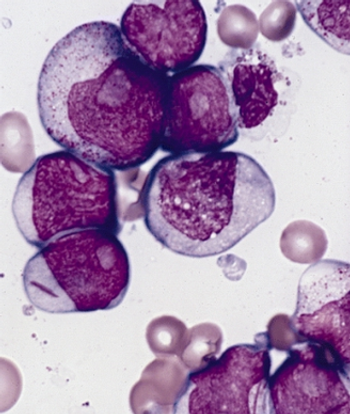
More than half of hematologists providing care to patients with hematologic malignancies reported initiating end-of-life conversations too late in the course of the patient’s disease.

Your AI-Trained Oncology Knowledge Connection!


More than half of hematologists providing care to patients with hematologic malignancies reported initiating end-of-life conversations too late in the course of the patient’s disease.

The success of allogeneic HCT in patients with AML varied among those with complete remission and minimal residual disease positivity vs negativity.

Ponatinib offered a better overall survival for chronic myeloid leukemia patients in chronic phase compared with allogeneic stem cell transplantation.

A case series of three individuals suggests that there may be a causal relationship between chemotherapeutic treatments for germ cell tumors and the subsequent development of chronic myeloid leukemia.

Real-time classification can identify a previously unrecognized subset of high-risk patients with childhood B-cell acute lymphoblastic leukemia who have excellent chances for cure without further intensification of treatment.

Single-agent ibrutinib resulted in significantly improved outcomes for older patients with chronic lymphocytic leukemia, compared with chlorambucil treatment.

Patients with relapsed or refractory CLL had significant delays in progression and death when idelalisib was added to bendamustine and rituximab.

The oral BCL-2 inhibitor venetoclax elicited a high rate of response from patients with high-risk relapsed or refractory chronic lymphocytic leukemia with 17p deletion.

Children with acute lymphocytic leukemia and their parents commonly over-report the amount of daily oral chemotherapy the child takes to treat the most common blood cancer in children.

Breast cancer survivors with therapy-related leukemia were found to have personal and family histories that suggested an inherited risk for cancer.

Genetic variants increase the risk of osteonecrosis in children under age 10 with acute lymphoblastic leukemia.

Researchers have identified a genetic variant, 2R thymidylate synthase polymorphism, that is associated with an increased risk for avascular necrosis in children with ALL.

In this interview we discuss the role of the tumor microenvironment in Hodgkin and non-Hodgkin lymphoma and research that seeks to disrupt and target this environment as a means of treatment.

A case study of a 15-year-old CML patient suggests that a reduced intensity conditioning regimen following hematopoietic stem cell transplantation could be a good treatment option for young CML patients. The patient went on to have two pregnancies with no neonatal complications.

PEG-asparaginase had both similar safety and efficacy to intramuscular native E coli l-asparaginase for the treatment of children with ALL in complete remission.

An increased risk for coronary heart disease was found with increasing mean heart dose of radiation in survivors of Hodgkin lymphoma.

Results from the phase II SORAML trial indicated that adding sorafenib to standard chemotherapy for younger patients with acute myeloid leukemia was effective, but also resulted in increased toxicity.

Many chronic myeloid leukemia patients who discontinue second-line dasatinib maintain a deep molecular response, according to a new study.

The presence of the gene KIR2DL5B was found to be associated with outcomes in patients with chronic phase chronic myeloid leukemia, according to a new study.

The use of reduced-intensity conditioning HSCT as a method to maintain remission was effective in a select group of older patients with acute myeloid leukemia.

In Hodgkin lymphoma survivors, both mean heart radiation dose and cumulative dose of anthracyclines significantly predicted cardiovascular disease.

In patients with chronic myeloid leukemia (CML), a prospective, long-term study has found that hematopoietic stem cell transplantation (HSCT) and drug therapy yielded similar 10-year survival outcomes.

The combination of chemotherapy with the TKI ponatinib was an effective treatment for patients with newly diagnosed Ph-positive acute lymphoblastic leukemia.

Allogeneic HSCT may be the best treatment option in older patients with acute myeloid leukemia who obtain first complete remission after induction chemotherapy.

A new risk assessment score more accurately reflects the probability of dying from chronic myeloid leukemia than do existing scoring systems.